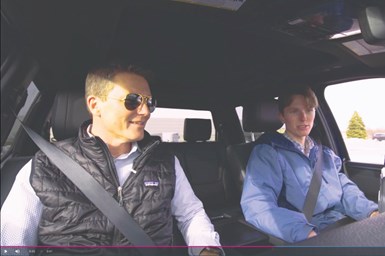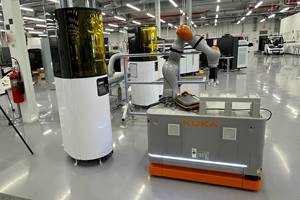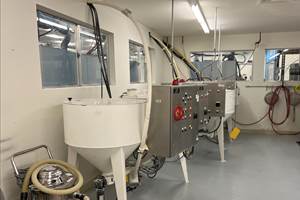Innovation is Revving Up: ‘Manufacturing Explorers’ Season 3
Buckle up and join Max and Travis as they talk about the thrills of visiting innovative automotive companies in the premiere of their third and final season of “Manufacturing Explorers,” an IMTS+ original series.
Numbers matter in Season 3 of “Manufacturing Explorers,” an IMTS+ Original Series, which premieres Sept. 28 on IMTS.com. Here are three critical numbers encountered by show stars (and father-son duo) Travis and Max Egan as they explore the automotive industry:
- 2 — The number of parts in the rear underbody section of the Tesla Model Y, down from 70 on the Model 3.
- 185,000 — The number of electronic circuit boards printed each week at this Tier 1 supplier.
- 6,000°F — The temperature of a plasma column that synthesizes EV battery elements.
Season 3 starts with a visit to Munro & Associates in Auburn Hills, Michigan. Sandy Munro, known as the “Teardown Titan,” deconstructs and analyzes vehicles, and he has particularly focused on EVs. The tour starts with Munro explaining the genius behind the Model Y design, and really any design that consolidates parts for optimization. Munro calls items such as bolts “unfasteners.” Any design that eliminates a connection is one less thing to go wrong, and it’s something he happily points out as part of Munro’s redesign services.
Munro also answers Max’s questions about EV battery recycling and battery life (you’ll be surprised), explores the design of electric motors (they are only about the size of a basketball!), and provides insights into design and manufacturing efficiency. In a twist of fate, a fender bender at home provides the opportunity to rent a Model Y, and it’s a contest to see who becomes the bigger fan and why.
For Episode 2, Max and Travis travel to Magna Electronics to meet up with another father-son duo, General Manager John Cunningham and Manufacturing Engineer Alex Cunningham. If you drive a modern vehicle, chances are you’ve experienced one of the millions of sensors manufactured by Magna, including those used for cruise control, parking assist, object detection and tailgate cameras. Watch as Max experiences one of Magna’s newer innovations, the Toyota Tundra trailer backup assist, then gets a firsthand look at how printed circuit boards are made.
In the final episode of Season 3, Max and Travis explore what might be the key to EV growth: the synthesis of Li-ion anode and cathode battery materials. Based in North Andover, Massachusetts, 6K Inc. created the UniMelt system, a production-scale microwave plasma process that produces critical materials. Pour in feedstock at the top, zap it with an ultrahigh, temperate 6,000° plasma gas, and high-value materials come out at the bottom. Where conventional battery materials production processes made from lithium, nickel and cobalt pose geopolitical risks, and mining damages the environment while also being fraught with fair labor issues, UniMelt is a green process that enables a diverse and reliable supply chain for EV battery components, leveraging both domestic and recycled feedstock.
Season 3 is also bittersweet, as it’s the final season with Travis and Max. The show started with Max as a young mechanical engineering undergraduate and Travis introducing him to his world of manufacturing. After one pandemic, five years, two degrees and 10 road trips with dad and a camera crew, Max is now pursuing his dream career as a lead analyst in the renewable energy industry.
Join Max and Travis as they talk about the thrills of visiting innovative automotive companies in the premiere of their third and final season of “Manufacturing Explorers,” an IMTS+ original series, at IMTS.com/ManufacturingExplorers.
Related Content
Aluminum Gets Its Own Additive Manufacturing Process
Alloy Enterprises’ selective diffusion bonding process is specifically designed for high throughput production of aluminum parts, enabling additive manufacturing to compete with casting.
Read MoreAutonomous Cobot Automation Increases Production 3D Printer Output for Ford (Includes Video)
A mobile robot that travels to each Carbon machine to unload builds lets the automaker run an additional three to four builds per machine per day. Autonomous robots fit well with 3D printing, but their role in production will extend beyond just the additive machines.
Read MoreA Tour of The Stratasys Direct Manufacturing Facility
The company's Belton manufacturing site in Texas is growing to support its various 3D printing applications for mass production in industries such as automotive and aerospace.
Read More8 Cool Parts From RAPID+TCT 2022: The Cool Parts Show #46
AM parts for applications from automotive to aircraft to furniture, in materials including ceramic, foam, metal and copper-coated polymer.
Read MoreRead Next
4 Ways the Education and Training Challenge Is Different for Additive Manufacturing
The advance of additive manufacturing means we need more professionals educated in AM technology.
Read MoreAt General Atomics, Do Unmanned Aerial Systems Reveal the Future of Aircraft Manufacturing?
The maker of the Predator and SkyGuardian remote aircraft can implement additive manufacturing more rapidly and widely than the makers of other types of planes. The role of 3D printing in current and future UAS components hints at how far AM can go to save cost and time in aircraft production and design.
Read More3D Printing Brings Sustainability, Accessibility to Glass Manufacturing
Australian startup Maple Glass Printing has developed a process for extruding glass into artwork, lab implements and architectural elements. Along the way, the company has also found more efficient ways of recycling this material.
Read More








.png;maxWidth=300;quality=90)














